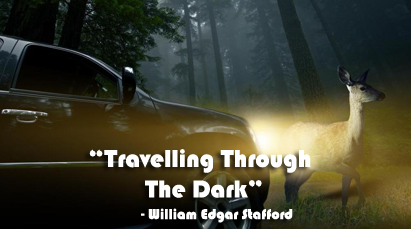ask
mattrab
Visit www.askmattrab.com for more academic resources.
Travelling Through the Dark - Summary and Important Questions
Important questions
1) What is the central idea of the poem?
Why is the narrator reluctant/unwilling to roll/push the doe into the canyon?
What is the irony of the poem?
What does the traveler feel when he touches the dead doe?
People generally travel in the dark when they have some immediate destination to reach. They kill innocent animals and immediately show pity on them. They behave like irrational creatures by killing them and leaving them on the roads. Finding a dead doe on the road, the speaker is in confusion either to show deep love and pity to the unborn fawn or to conserve nature. After deep meditation, he pushes the dead doe into the river. The word 'darkness' refers to one of nature's beautiful creatures that have been killed pitilessly, left on the road, and unburied. The driver's inaction suggests moral darkness. The darkness also suggests the speaker's confusion about what to do with the deer. The title 'Travelling Through the Dark' symbolizes the spiritual void of human beings in this insensitive world. Thus, the poem is ironic.
2) What are the two activities in this poem?
How do the last two lines complete both the types of action in the poem Travelling Through the Dark'?
The poem Travelling Through the Dark' composed by William Stafford presents both physical and mental actions. Traveling through the dark is the physical action while thinking of rolling the dead doe into the canyon is the mental action, activities. When he touches the deer's side, he knows about the presence of the fawn inside. This physical action leads to the Speaker stops his car, gets down from it, goes up to her and drags it by the side of the road. All these are physical the mental action. This unhappy realization causes him to hesitate. Finally, he thinks deeply and knows that: his love and pity for the fawn cannot save it. Pushing the deer into the river, he marches towards his destination.
3) Why do you think the reference to the alive but never-to-be-born fawn sentimental?
Undoubtedly, I think that the reference to the alive but never-to-be-born fawn is sentimental. When the speaker touches the deer's side, he comes to know that the fawn inside the doe is still alive. But as its mother is dead, the fawn is sure to die. It evokes emotions warmer than efficiency and deeper than judgment. By the reference, readers feel pity on the fate of the helpless fawn inside the dead doe.

